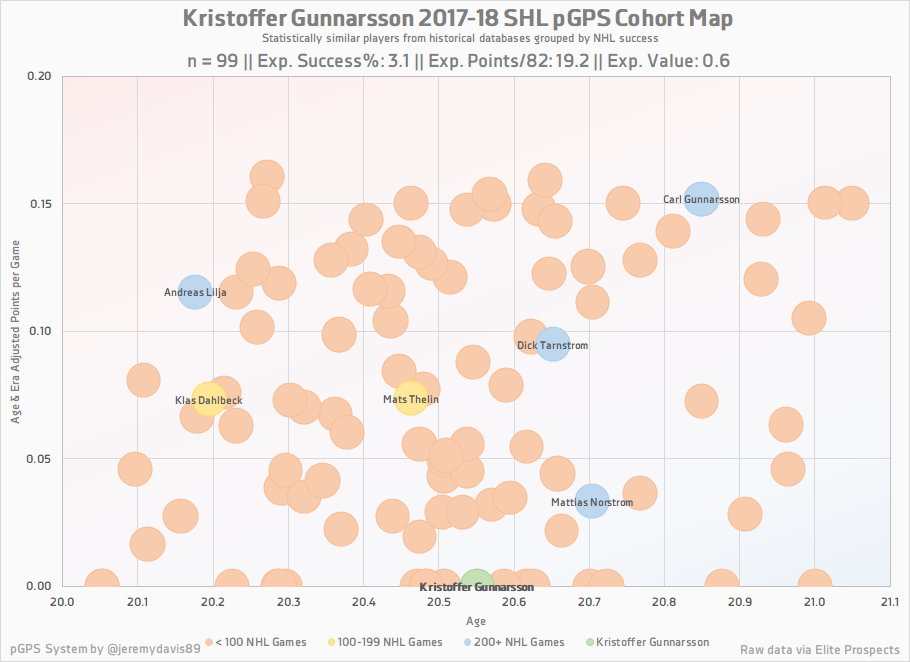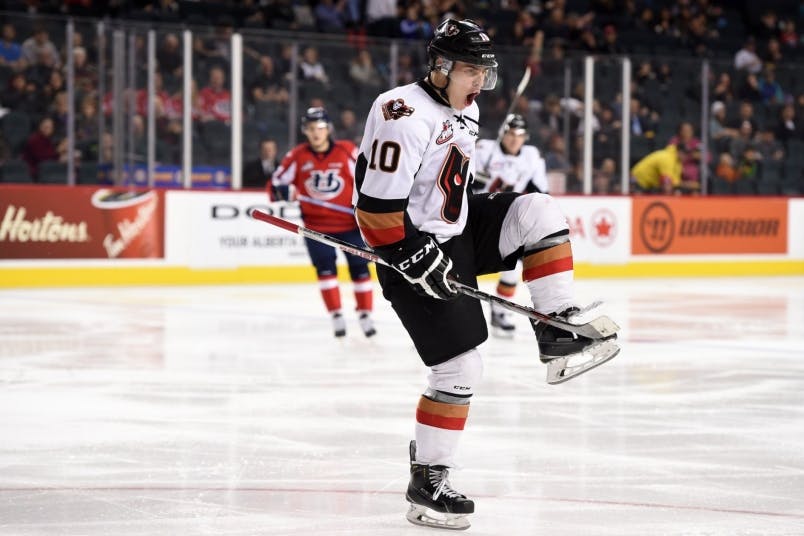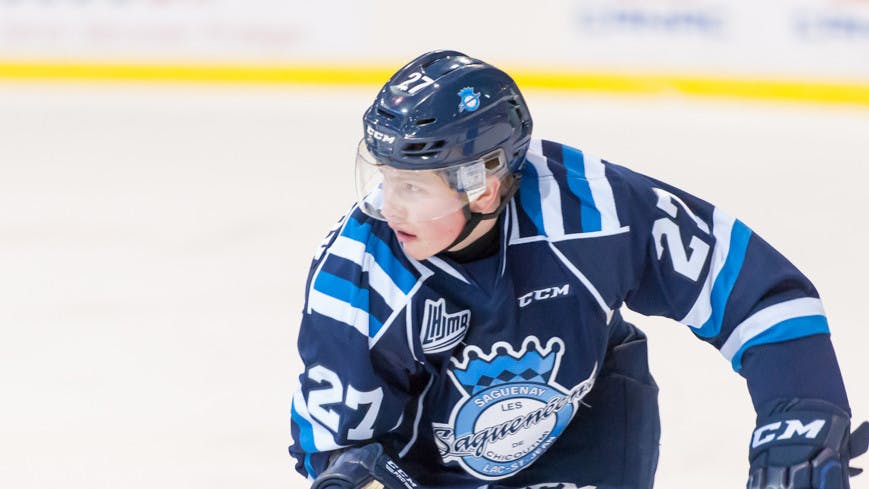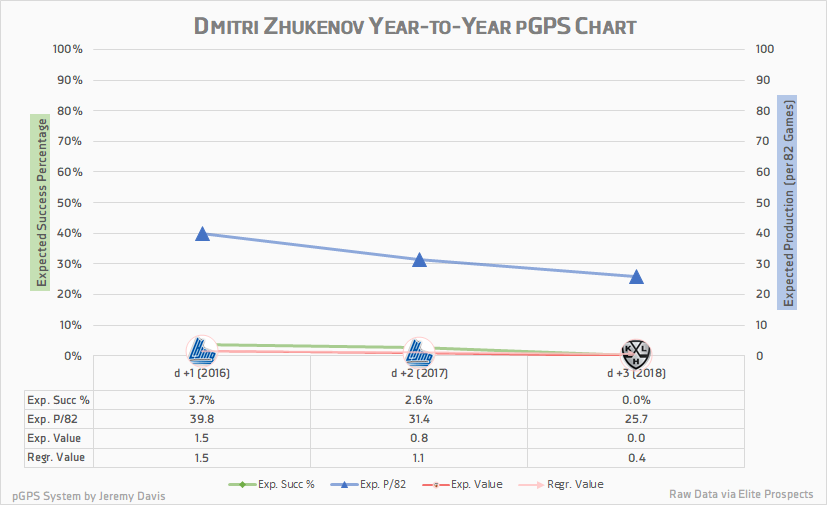Canucks Army’s 2018 Midterm Prospect Rankings: 27th to 25th

By Jeremy Davis
6 years agoIt’s finally time for the next segment of our 2018 midterm prospect rankings. Apologies for the three-week gap since the last one was published – I had some personal matters that needed attention. We don’t intend to make a habit of long gaps from here on. As we get towards to the meat of the list, they should start rolling fast and furious.
As it is, we’re still in the region of the prospect pool where it’s a bit of a slog. This next group of prospects isn’t quite as dreadful as the last set, but suffice it to say that hopes aren’t particularly high for these players either. Still, it’s our duty to assess them as individuals and determine why they’ve ended up as far down the list as they have.
First, a quick review of how these rankings were formed. Seven lists, including six from Canucks Army writers (myself, J.D. Burke, Ryan Biech, Jackson McDonald, Vanessa Jang, and Janik Beichler) plus the reader rankings, were consolidated into one list. The parameters are that each prospect must:
- be under the age of 25;
- have played fewer than 25 NHL games; and
- be under contract to the Vancouver Canucks or on their reserve (e.g. as an unsigned draft choice).
Let’s get on with the list. Here are the 27th, 26th, and 25th ranked Vancouver Canucks prospects.
#27: Kristoffer Gunnarsson
Preseason ranking: Unranked

Age: 20 – Position: Defence – Shoots: Left – Height: – 6’1″ – Weight: 205 lbs

We’ve come to our first prospect from the 2017 draft, which looks, at this point, to be Jim Benning and co’s best draft to date. Given the options that they had at the positions they were in, the Canucks fared very well at that draft, with some real potential bright spots in the later rounds. The only player that we weren’t crazy about was Swedish defenceman Kristoffer Gunnarsson, and that’s why (spoiler alert) he’s the only 2017 selection outside of our top 20.
Gunnarsson was taken in the fifth round (135th overall) with one of the two picks that the Canucks received in exchanged for the 119th overall pick. First of all, that pick came from San Jose in the Jannik Hansen trade that already netted the Canucks Nikolay Goldobin, so all of this is just gravy. Next, from an odds perspective, trading a fourth round pick for a fifth and sixth round picks is a prudent move, and in most cases, you’d come out ahead. Finally, the Canucks used the other pick (181st overall) on Petrus Palmu, who was fantastic value where he was taken, which means that the trade already looks more than acceptable no matter what happens with Gunnarsson.
All in all, the Canucks don’t really need Gunnarsson to pan out to make out like bandits on the Hansen trade, but it would be nice. If we’re being honest though, chances don’t look particularly rosy.
The thing that really draws your eye on Gunnarsson’s boxcars are the zeroes – and there’s a lot of them. Gunnarsson has played games in the SHL, Sweden’s highest league, in parts of each of the last three seasons. He’s played a total of 85 SHL games, between regular season, playoffs and about a dozen Champions Hockey League games, and to show for it he has zero goals, zero assists, and of course, zero points. He has managed to pick up 59 minutes in penalties, so there’s that.
We often say that production is a secondary bonus, and just playing in the SHL is a strong sign for prospects. However, this is taking it a bit to the extreme. His Expected Likelihood of Success is above zero, though not by much.

Gunnarsson is averaging just 10:11 per game, placing him securely in the range of a seventh defenceman (the SHL, like many European leagues, allows teams to dress 20 skaters for each game). He’s second on his team (Frolunda HC) in hits (with 33) and fifth in blocks (with 28), and first and third in those stats by rate, and he’s even in 5-on-5 goal differential. He’s averaging 2:25 per game on the penalty kill, which is fourth highest on the team, and nearly a quarter of his total ice time, indicating that his coaches trust him enough in that role to keep him around for it.
On the flip side, he’s generated just 13 shots on goal, and an additional 22 that missed the net. Other levels of competition haven’t led to substantially improved numbers either, with two points in 29 Allsvenskan games and two points in 20 under-20 international games last season.
Defensively, there’s a lot to like about Gunnarsson. The issue, of course, is that there’s little to no offence to go along with it. It begs the question: what did the Canucks see in him? While that question hasn’t been answered in its entirety, we were provided with this exchange in a behind the scenes video from the draft.
Benning: “Gunnarson’s playing in the Swedish elite league. We can leave him over there for two years…”Brackett: “I’m fine with Gunnarsson. Even when you look at our American League depth, he can come over soon.”Benning: “We’ll let him stay there [in the SHL] another year and then bring him over, and he can play in the American League.”
I at least get the logic of picking a teen-aged defender playing in a pro league, and that leaving him there is going to be a wise development path. I don’t really see him doing anything more than providing American league depth though, and in that vein, I don’t entirely see the logic in using a draft pick on a player to add depth to your AHL roster, since there are thousands of free agent players available for that purpose elsewhere. In a matter of years, Gunnarsson would have been a draft related free agent and the Canucks could have brought him over to Utica without using a draft pick on him.
But what’s done is done. If Gunnarsson is indeed a sturdy defensive presence, maybe they can make use of him for a couple of seasons in Utica. Given the complete lack of offensive upside, I’m not sure how valuable he’d be the Comets long term, and I certainly don’t see him as a future NHL option at this point.
#26: Jakob Stukel
Preseason ranking: Unranked

Age: 20 – Position: Left Wing – Shoots: Left – Height: – 6’0″ – Weight: 190 lbs

Jakob Stukel was taken in the sixth round (154th overall) at the 2016 NHL Entry Draft, in his second year of eligibility. A decent bet in the late rounds at the time, Stukel’s production has failed to progress over the last couple of seasons, and at this point he seems like little more than a candidate to re-enter the draft this June, which will be the case if the Canucks neglect to sign him by June 1st.
What made Stukel intriguing in his draft-plus-one year (the season prior to the Canucks taking him), is that his production jumped up following a trade from the Vancouver Giants to the Calgary Hitmen. Stukel had four points in 12 games with the Giants (0.33 points per game) after scoring 0.33 points per game in his draft year. Following the trade, he tallied 56 points (including 34 goals) in 57 games (0.98 points per game) with the Hitmen, a massive increase.
There are a number of factors that could account for this. They range from an increase in opportunity (e.g. ice time, power play time), to better quality of teammates, to a better fit to his skill set, or even psychological or social factors. Some of these are measurable, while others are not, and that’s a challenge for bloggers who get limited access to prospects – we’re often stuck guessing when it comes to internal factors.
There’s little doubt that Calgary was, at the time, a better team than Vancouver (7th in league standings, versus 21st). During Stukel’s tenure in Vancouver, there were few WHL teams who were worse than the Giants. A change of scenery to a substantially better team could easily result in better production. That season, Stukel’s highest overlap of on-ice events was with Jake Bean, a 13th overall pick.
The problem with Stukel is that his production stagnated. In 2016-17, he tallied one extra point in one extra game (which was actually a decrease in production if you consider only his rates with the Hitmen). This season, he looks to be on pace for similar point totals. In junior hockey, the age range is tight, and growth is substantial. If your production rates aren’t moving forwards, you are essentially moving backwards.

Stukel scores his fair share of goals, and they usually involve a common denominator: his speed. Stukel’s wheels are undeniably impressive, and they put him in a position to create breakaways and odd man rushes. Unfortunately, his speed is his only notable quality, and nearly every other aspect of his game is underdeveloped for his age. As mentioned, if Stukel isn’t signed by June 1st, the Canucks will relinquish his rights. At this point, I have to imagine that’s what we will see happen.
#25: Dmitry Zhukenov
Preseason ranking: Unranked

Age: 20 – Position: Centre – Shoots: Right – Height: – 5’11″ – Weight: 176 lbs

Dmitry Zhukenov is a prospect that I’ve often been a fan of. I liked his selection (fourth round, 114th overall) back in 2015, and I liked what I saw from him when he came to North America following a Chicoutimi selection in the 2015 CHL Import Draft. He’s a quick, two-way player with some flair to his game and a propensity for dangles from time to time. His production in his draft-plus-one season (2015-16) was a little underwhelming (57 points in 65 games) for a player of his age in the QMJHL. Still, the Sagueneens were an exceptionally bad team, and I was willing to give him the benefit of the doubt.
Last season showed some minor improvement, with Zhukenov just barely breaking the point per game pace. Unfortunately, for a draft-plus-two centre in the QMJHL, this is far from impressive production. That said, Zhukenov really began to shine in the 2017 QMJHL playoffs, as Chicoutimi went on a bit of a run, largely on the backs of Zhukenov and some high end NHL draft picks like Nicholas Roy and German Rubtsov. By the end of that run, it started to seem like Zhukenov had worked his way back into the conversation as a Canucks prospect.
Then he went and signed overseas.

Now, by and large, a European signing in Europe after spending time in North America is not necessarily an issue. Consider that Canucks fans and media were very supportive of the idea of Olli Juolevi (and, to a lesser extent, Petrus Palmu) heading to the Finnish Liiga after spending a couple of seasons in the OHL. Additionally, with two of the Canucks top prospects playing in Sweden, there’s hardly been a better time to play in Europe and still maintain relevance.
Unfortunately for Zhukenov, it’s extremely difficult to maintain relevance when you’re hardly playing. Zhukenov has had all sorts of trouble staying in the lineup for Avangard Omsk, the KHL team he signed a multi-year contract with. He’s split time between the KHL and the Russian junior league, MHL, this season, with middling results.
In the KHL, he has just one goal to show for 15 games played, granted, the 8:42 he averaged in ice time doesn’t exactly scream “opportunity”. There’s little else to go on here, but I’d suggest that Avangard, who are struggling to maintain a playoff spot right now, don’t have a whole lot of trust in the young centre.
In the MHL, Zhukenov has 19 points in 23 games, good for 0.83 points per game, which is 84th in that league by rate. For a 20-year old in an under-20 league, that’s pretty far from promising. The MHL is a bit tricky to predict, given that it’s been in existence for less than a decade, but just given how he compares against the rest of that league, I’d venture a guess that his performance there so far is a bit of a disappointment if you were still hoping for him to turn into an NHL player.
The Canucks still have another year and a bit before they relinquish his rights, given that he was playing outside North America prior to being drafted. After a tumultuous year back home, you might think that he’d want to give North America another shot, and maybe take a run at joining the Comets in 2018-19. According to Elite Prospects, he’s still under contract to Omsk next season, so there’s no guarantee that that will even be an option.
Recent articles from Jeremy Davis





